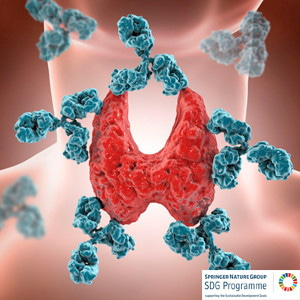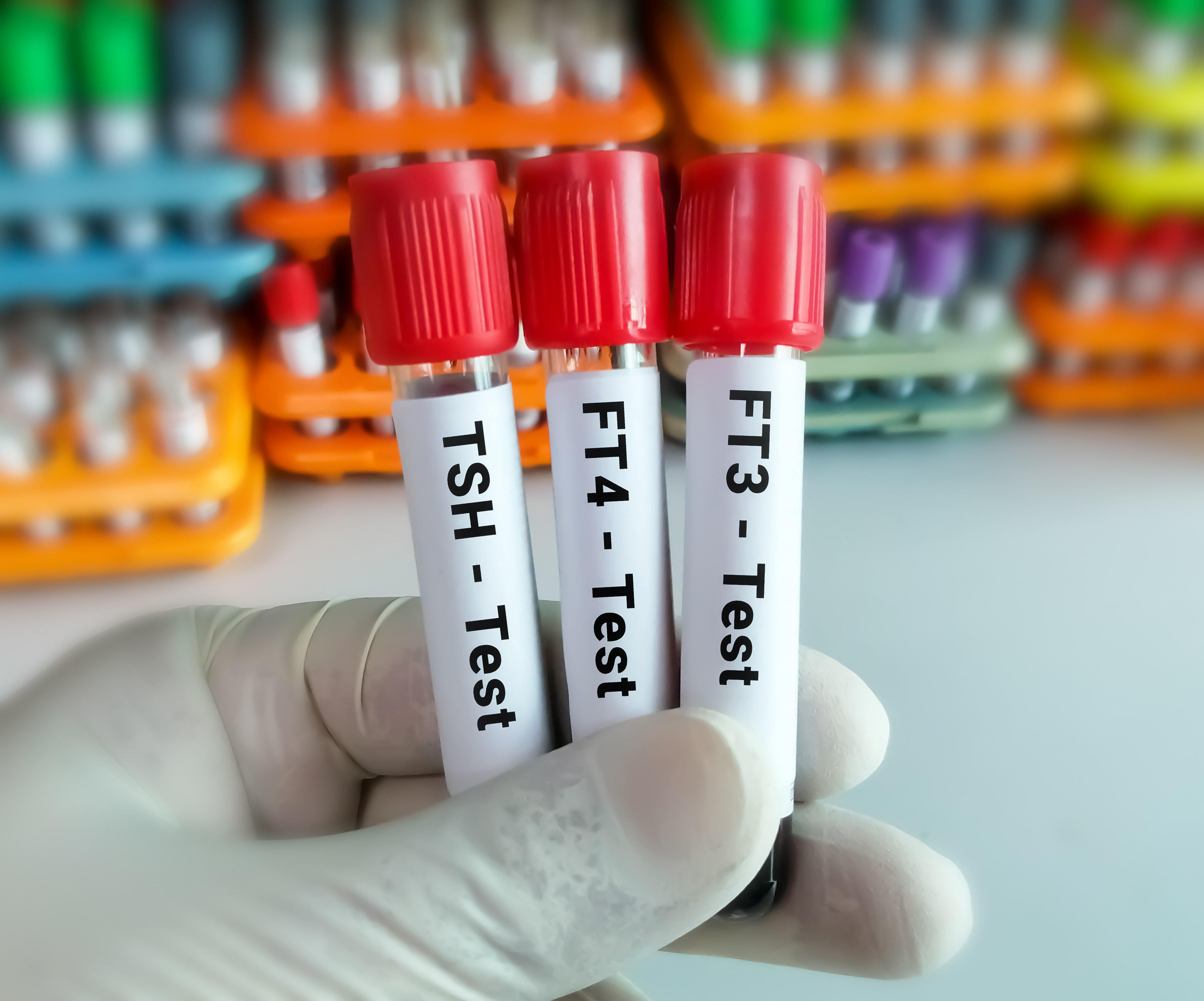Thyroid Awareness Month: Highlights from the BMC Series
Published in General & Internal Medicine and Anatomy & Physiology

The thyroid is a small, butterfly-shaped gland in the front of the neck that produces hormones. It’s often called the ‘orchestra of the hormones’ because it affects almost every organ in the body. According to the World Health Organization, an estimated 750 million people worldwide have some form of thyroid disorder. In the UK, it’s believed that 1 in 20 people are affected, with women being disproportionately impacted. January marks National Thyroid Awareness Month, a time dedicated to raising awareness of thyroid-related diseases and thyroid cancer. In response to this call to raise awareness, we highlight key related research from the BMC Series.
BMC Endocrine Disorders - Best practices in the laboratory diagnosis, prognostication, prediction, and monitoring of Graves’ disease: role of TRAbs

Graves’ Disease (GD) is an autoimmune disorder causing the overproduction of thyroid hormone in the body (hyperthyroidism). It is characterized by activation of the thyrotropin receptor by stimulatory autoantibodies (known as TSH Receptor Antibodies, or TRAbs), which leads to unregulated thyroid hormone production. This can cause symptoms including palpitations, sweating, and weight loss.
One key test that is regularly used in developed countries for managing GD is the TRAb test. TRAb is especially helpful for confirming the diagnosis, helping doctors determine the best treatment, predicting how the disease will progress, and monitoring thyroid function, particularly during pregnancy and in newborns. This consensus article develops the best practice guidelines for the management of GD in South Asia, including the Indian subcontinent, by a group of experienced endocrinologists. These guidelines propose that TRAb testing can make diagnosing GD more accurate, faster, and more cost-effective. By providing a clear diagnosis, the TRAb test can reduce the need for other expensive, time-consuming tests, thus improving both treatment accuracy and patient satisfaction.
TRAb test can also be used in other clinical settings, such as counselling women before pregnancy, managing GD during pregnancy, and monitoring thyroid function in newborns. Overall, the evidence from this consensus statement supports the view that TRAb testing plays a crucial role in managing GD effectively, and its use can help reduce the time to diagnosis and improve patient care, especially in South Asia.
BMC Immunology - Potential role of IGF-1R in the interaction between orbital fibroblasts and B lymphocytes: an implication for B lymphocyte depletion in the active inflammatory phase of thyroid-associated ophthalmopathy

Thyroid Eye Disease (TED) is an autoimmune disease that causes inflammation in the tissues around the eyes. It also leads to discomfort, swelling, and, in some cases, vision problems. A study published in BMC Immunology explores the biological processes behind TED, focusing on the specific protein insulin-like growth factor-1 receptor (IGF-1R) that may play a key role in the condition’s progression.
The research involved sampling orbital fibroblasts from orbital connective tissues of patients diagnosed with TED and comparing these with samples from healthy individuals. To understand the behaviour of these cells, the researchers measured the expression of IGF-1R in the fibroblasts using advanced techniques, such as flow cytometry and confocal microscopy.
The study found that IGF-1R expression was significantly higher in TED orbital fibroblasts compared with healthy individuals’ fibroblasts, suggesting that blocking IGF-1R may help reduce local inflammation. Another key finding was that rituximab, a drug that targets B lymphocytes, reduced inflammation in the co-culture model of TED, suggesting that rituximab or similar treatments may help manage TED by reducing inflammation. This study highlights the importance of understanding the immune mechanisms behind TED.
BMC Primary Care - Thyroid function status in patients with hypothyroidism on thyroxine replacement and associated factors: a retrospective cohort study in primary care
.jpg)
Hypothyroidism is a condition where the thyroid gland doesn’t produce enough hormones, and people with this condition often need to take levothyroxine, a synthetic form of the thyroid hormone thyroxine. However, taking the medication alone isn’t enough; regular monitoring of thyroid levels is also important. In this study, the authors examined how well people with hypothyroidism managed their condition on long-term thyroxine replacement therapy and whether the timing of these tests made a difference in their thyroid function.
This study involved adults diagnosed with hypothyroidism in Singapore between July 2017 and June 2020. Researchers collected data from electronic health records and monitored the thyroid status of patients over two years. Follow-up thyroid status was grouped into three categories based on their thyroid-stimulating hormone (TSH) levels: under-replacement, over-replacement, or euthyroid.
The authors found that about 60% of participants maintained normal thyroid function with thyroxine replacement for hypothyroidism in primary care over a two-year period. Under-replacement of thyroxine (in 30% of people) was more common among males and individuals with obesity. Those in the over-replacement group had a higher daily thyroxine dose compared to the other two groups.
The study highlights that, with regular monitoring, most people taking thyroxine for hypothyroidism can achieve and maintain normal thyroid function. However, finding the right dose of thyroxine and monitoring regularly is crucial, especially for those at higher risk, such as men and obese individuals. The study further indicates that a well-balanced approach to testing and adjusting medication can help patients avoid the risks of being under- or over-treated. The researchers therefore suggest that primary care physicians should first assess the patient’s adherence to their medication and identify any factors that might interfere with the effectiveness of the thyroxine treatment, before considering another TFT.
BMC Endocrine Disorders - Thyroid function spectrum in Cushing’s syndrome

Cushing’s syndrome (CS) is a metabolic disorder caused by excessive secretion of cortisol; a hormone that helps the body respond to stress. Excessive cortisol levels can cause systemic organ damage and disrupt the function of the pituitary-adrenal axis. Glucocorticoids also affect pituitary–thyroid axis function, though the exact effects on thyroid function in CS patients are not yet fully understood.
A cross-sectional study published in BMC Endocrine Disorders involved screening patients over a three-year period and collecting data on demographics, medical history, and laboratory results. The study also performed a meta-analysis to assess the prevalence of thyroid dysfunction in patients with CS. The researchers found that patients with clinical CS showed more pronounced thyroid suppression than those with subclinical CS. Cortisol levels were significantly higher in patients with pituitary hypothyroidism. Using a low-dose dexamethasone-suppression test (LDDST), the study authors further identified that changes in serum cortisol levels throughout the day correlated with thyroid hormone levels, particularly in cases of adrenocorticotropin (ACTH)-independent CS.
The research concluded that thyroid hormone levels are closely linked to cortisol levels and are often affected in people with Cushing’s syndrome. However, continued research is needed to fully understand how the body adapts to these changes and what it might mean for patients in the long run.
Call for papers!
If you’re interested in learning more about thyroid disorders, explore the following collection from BMC Endocrine Disorders that is currently open for submissions:
Follow the Topic
-
BMC Primary Care

Previously known as BMC Family Practice, this is an open access, peer-reviewed journal that considers articles on all aspects of primary health care research.
-
BMC Endocrine Disorders

This is an open access, peer-reviewed journal that considers articles on the characterization, prevention, diagnosis and treatment of endocrine disorders.
-
BMC Immunology

This is an open access journal publishing original peer-reviewed research articles in molecular, cellular, tissue-level, organismal, functional, and developmental aspects of the immune system as well as clinical studies and animal models of human diseases.
Related Collections
With Collections, you can get published faster and increase your visibility.
Cancer immunology and immunotherapy
BMC Immunology is calling for submissions to our Collection on Cancer immunology and immunotherapy. Cancer immunology and immunotherapy have emerged as pivotal areas in cancer research, focusing on understanding the complex interplay between the immune system and cancer cells. This field encompasses the study of tumor immunology, immune evasion mechanisms, and the development of immunotherapeutic strategies to harness the immune system's potential to target and eliminate cancer cells.
Advancing our collective understanding is crucial for the development of novel immunotherapies, such as immune checkpoint inhibitors and chimeric antigen receptor (CAR) cell therapies, which have shown remarkable efficacy in treating various types of cancer. Furthermore, research in this area has elucidated the role of the tumor microenvironment in modulating immune responses and has provided insights into mechanisms of immune evasion and tumor metastasis.
Potential topics for submission include, but are not limited to:
- Personalized cell therapies, including various CAR cells
- Cancer prevention such as vaccines
- Tumor microenvironment and metastasis
- iImmunoediting: elimination, equilibrium, and escape
- Inflammaging - the bidirectional relationship between cancer and inflammation
This Collection supports and amplifies research related to SDG 3: Good Health and Well-being.
All manuscripts submitted to this journal, including those submitted to collections and special issues, are assessed in line with our editorial policies and the journal’s peer-review process
Publishing Model: Open Access
Deadline: Jun 09, 2026
Bridging primary and palliative care
BMC Primary Care is calling for submissions to our Collection, Bridging primary and palliative care. The integration of primary and palliative care is increasingly recognized as essential for improving the quality of life for patients with serious illnesses. This Collection invites research that examines innovative models of care that bridge these two critical domains. The interplay between primary care and palliative care can enhance the patient experience by addressing not only medical needs but also psychosocial and spiritual aspects of care. As healthcare systems evolve, understanding how these two areas can collaborate effectively is crucial for optimizing patient-centered approaches and ensuring comprehensive support for individuals and families.
Advancements in this field highlight the importance of shared decision-making and advanced care planning as mechanisms to enhance communication between healthcare providers and patients. By fostering a collaborative environment, we can empower patients to express their preferences and values concerning their care journey, particularly in the context of end-of-life decisions. Research has shown that integrated approaches lead to better symptom management, reduced hospitalizations, and increased patient and family satisfaction. Ongoing research could transform how we think about and deliver care for patients with serious illnesses.
In this Collection, we welcome submissions that span a wide array of topics, including but not limited to:
- Integrating advanced care planning in primary care
- Shared decision-making in end-of-life care
- Models of palliative care in primary care settings
- Enhancing communication between care teams
All manuscripts submitted to this journal, including those submitted to collections and special issues, are assessed in line with our editorial policies and the journal’s peer-review process. Reviewers and editors are required to declare competing interests and can be excluded from the peer review process if a competing interest exists.
Publishing Model: Open Access
Deadline: Jun 08, 2026





Please sign in or register for FREE
If you are a registered user on Research Communities by Springer Nature, please sign in